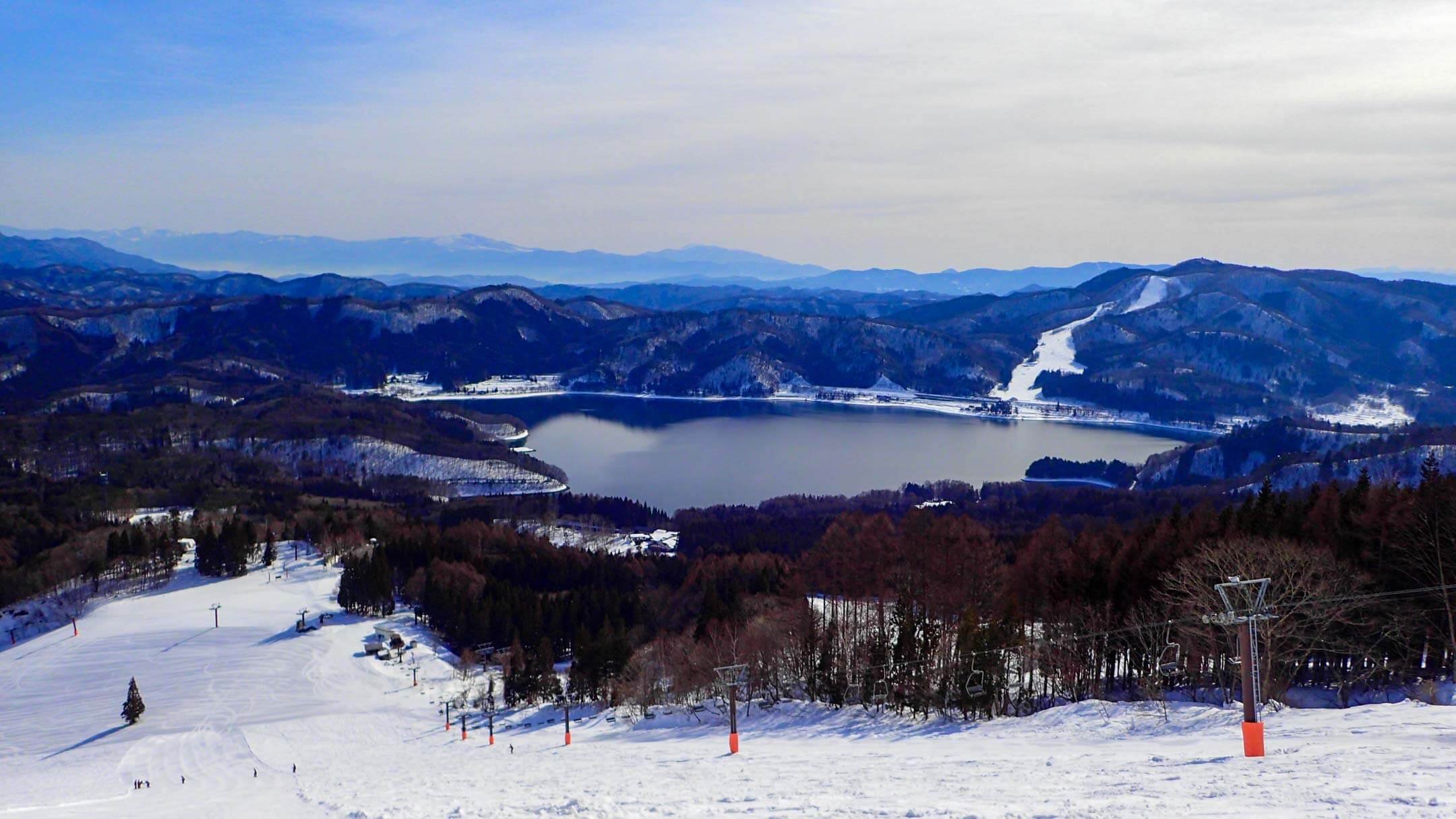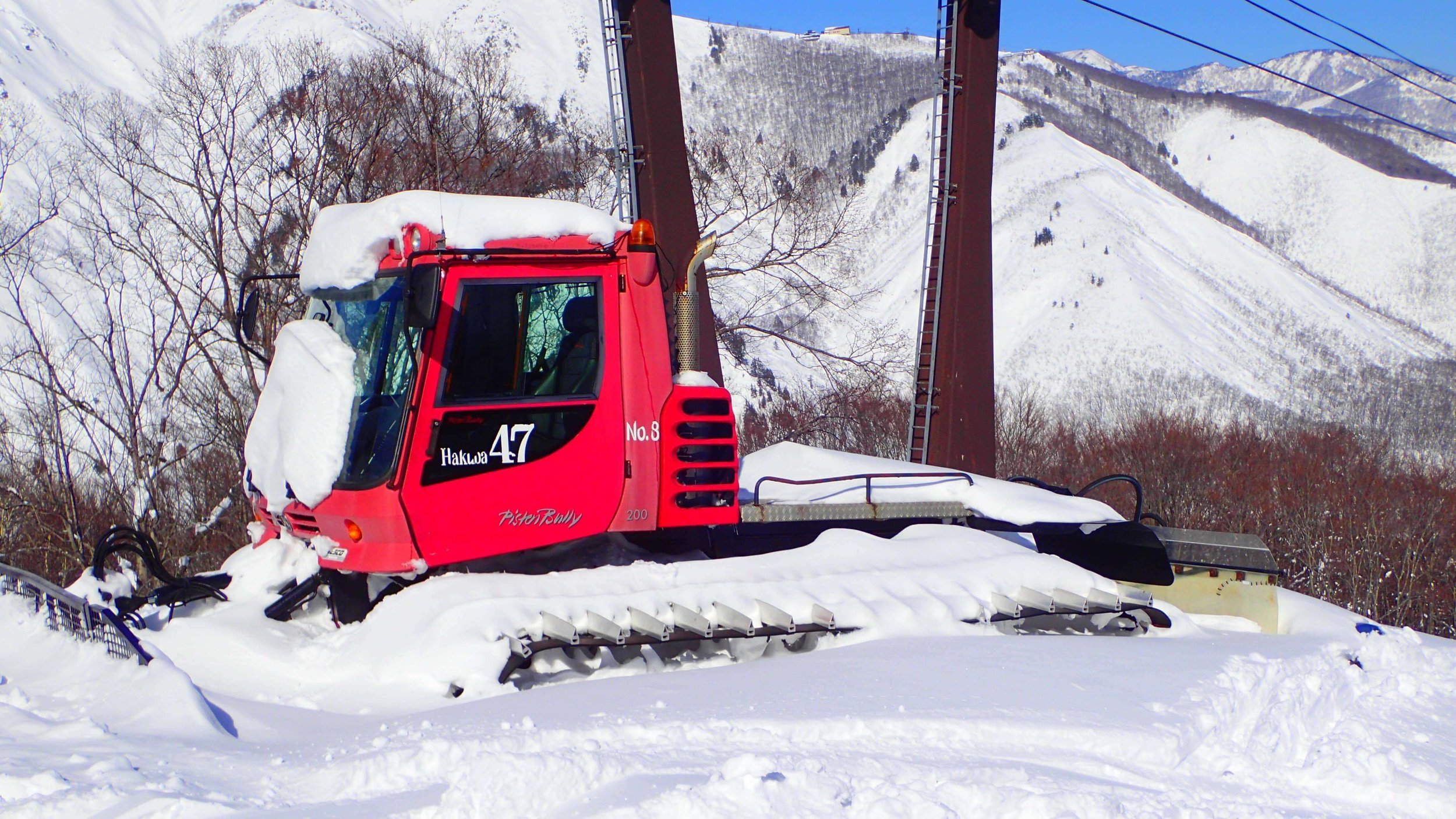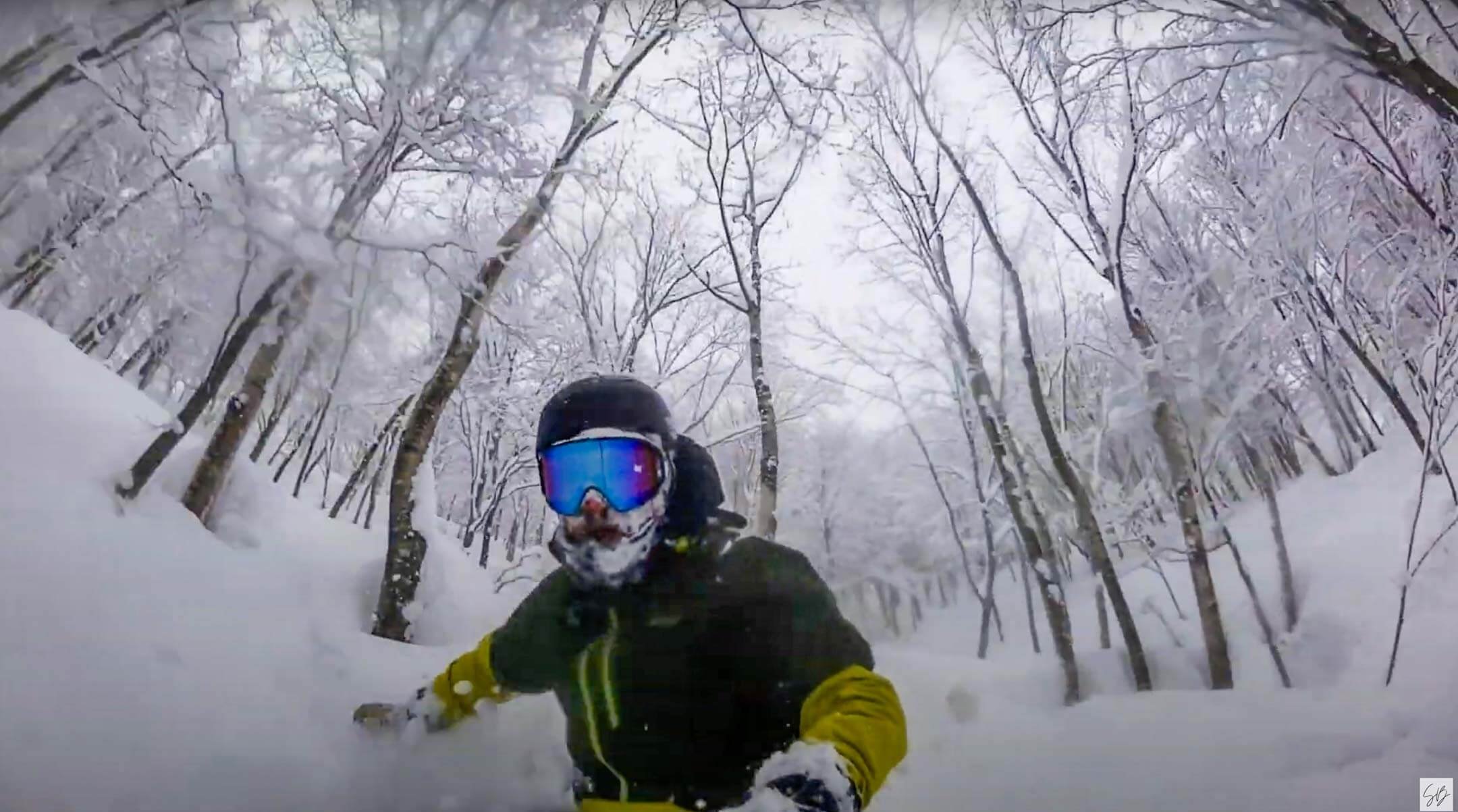HAKUBA SANOSAKA
Set in a beautiful location overlooking Lake Aokiko and away from the hub surrounding Happo One, Sanosaka is off the beaten track. A combination of Sanosaka’s location and an irregular bus service ensures that Sanosaka remains a crowd-free resort. People regularly use the terms quiet or crowd-free to describe ski resorts but at Sanosaka I genuinely felt that I was the only person there. Sanosaka is overlooked by many visitors which is an oversight as Sanosaka offers incredible views and uncrowded slopes.
SANOSAKA FIRST IMPRESSIONS
Arriving at Sanosaka you would be forgiven for thinking you are in the wrong place. The bus drops you at the road, a short walk into the resort. As you head through the car park you will notice there are very few cars and you know you will have a good day ahead. This feeling is amplified as soon as you walk through the main doors at the base area where I was met by @jupbrown an enthusiastic Kiwi who manages the resort. I have honestly never felt so welcomed at a ski resort and this personal touch makes a big difference.
HAKUBA SANOSAKA SKI AREA
Even for Japanese resorts, it’s fair to say that Sanosaka is small. One of the smallest resorts in the Hakuba Valley with a vertical drop of 460m and 5 chairlifts Sanosaka is easily overlooked. Looking at the trail map doesn’t really do Sanosaka justice.
At Sanosaka the limited terrain is well maintained with perfect wide groomed pistes making it perfect for working on those carves. With 60% of the runs classified as red or black, Sanosaka is a resort that can offer a challenge although no pitch is particularly steep. There are plans for development at Sanosaka with the resort looking to purchase the closed down Aokiko which sits between Sanosaka and Kashimayari. This would significantly increase the ski area and make riding from Sanosaka to Kashimayari possible by chairlift.
My favourite run was Lake Down Trail which I continuously lapped. This run has some of the best views in the resort and is a nice wide groomer with some small park features at the bottom. This run made my list of the BEST FIVE RUNS IN HAKUBA.
BEGINNERS TERRAIN AT HAKUBA SANOSAKA
Beginners will find learning at Sanosaka particularly enjoyable. Firstly the terrain near the base area has a suitable learning slope with everything needed for your first lessons nearby; ski school, rentals, etc. With some mellow blue terrain, Sanosaka would be a particularly nice resort for beginners to progress at as they can head out around the rest of the Hakuba mountains.
INTERMEDIATE TERRAIN AT HAKUBA SANOSAKA
Intermediates will thrive at Sanosaka with most of the terrain at Sanosaka being nice wide groomed runs. Sanosaka ski resorts Lake Down Trail is the best of these with a wide pisted run down to a small terrain park nearer the chairlift. There is little to worry intermediate skiers and snowboarders at Sanosaka and they may even be tempted by the kinder black-graded terrain.
ADVANCED TERRAIN AT HAKUBA SANOSAKA
The advanced terrain at Sanosaka is negligible with only a couple of runs having any real pitch to them. Two steeper pitch runs in area C of the trail map alongside a mogul course near the base area are probably the pick of the lot at Sanosaka.
FREESTYLE TERRAIN AT HAKUBA SANOSAKA
There is a small terrain park at Sanosaka that consisted of two medium-sized jumps and some ride on tubes and rails. Better terrain parks are available elsewhere in the Hakuba Valley.
LIFTS AT HAKUBA SANOSAKA
Five chairlifts seem excessive for a resort of Sanosaka’s size but the lift infrastructure is pretty good. A fast lift from the base area into the main area of the resort alongside another fast lift that allows you to lap Lake Down Trail. Further slower two and three-person lifts make up the rest of the offering at Sanosaka.
HAKUBA SANOSAKA PROS
Hakuba Sanosaka ski area is quieter than the other Hakuba Valley ski resorts.
No lift lines make Sanosaka ski resort particularly appealing
Sanosaka’s great groomed terrain makes it a fantastic resort to hit first thing in the morning.
It would be interesting to hit Sanosaka on a powder day as you would have no crowds to fight with for freshies.
HAKUBA SANOSAKA CONS
Hakuba Sanosaka has a poor transport link up with the rest of Hakuba meaning bus options are few and far between.
Further from the centre getting to Sanosaka ski resort takes longer which can eat into your on snow time.
HAKUBA SANOSAKA SNOW RECORD
Sanosaka ski resort is in the Hakuba Valley which receives copious amounts of snow. At the other end of the Valley to Cortina which receives 12m per season, Sanosaka’s snow stats are less readily available. Sanosaka will receive less snow than Cortina but it will still receive around 8-10m of snow per winter.
TRAVEL TO SANOSAKA
Travel to Hakuba 47 in Hakuba Valley is most commonly accessed from Tokyo Airport via several convenient options. From either Narita or Haneda Airport, travelers can take the JR Hokuriku Shinkansen to Nagano Station, which takes about 1.5 to 2.5 hours depending on the service. From Nagano Station, a direct bus or taxi can bring you to Hakuba in roughly one hour. Alternatively, there are express airport limousine buses that travel directly from Tokyo airports to Hakuba, offering a comfortable and straightforward journey.
When arriving at Tokyo airports—Narita (NRT) or Haneda (HND)—you have convenient options to ship your luggage directly to your hotel, making travel through the city easier and more enjoyable.
Luggage Delivery Services:
Takuhaibin (宅配便)
This is Japan’s comprehensive door-to-door delivery service, widely used for shipping bags between airports, hotels, and other locations. Major providers include Yamato Transport (Kuroneko Yamato), Sagawa Express, and Japan Post.Where to find service desks: At both Narita and Haneda airports, look for dedicated Takuhaibin counters or kiosks near the baggage claim area or arrivals hall.
Costs: Typically range from 1,500 to 3,000 JPY per bag, depending on size and destination. Expect a fee on the higher end for same-day or next-day delivery.
Time: Delivery generally takes 1 to 2 days, but many Hakuba hotels receive luggage the next day if shipping early.
How to Ship:
Bring your luggage directly to the Takuhaibin counter at the airport.
Provide your hotel’s address, phone number, and your planned check-in date.
Fill out a simple form; staff often can assist in English.
Pay by cash or credit card.
You’ll receive a receipt with a tracking number.
Shipping to Hotels:
Most hotels in Tokyo are familiar with and accept Takuhaibin luggage deliveries for their guests. Always inform your hotel ahead of time with the expected delivery date and provide your name to avoid confusion. Some luxury hotels may charge a small handling fee, so check in advance.Timing and Planning:
Shipping luggage ahead means you can travel light on public transport or have more freedom to explore Tokyo immediately after arrival. However, avoid shipping your bags to hotels with insufficient lead time—send luggage early enough to ensure it arrives before or on your check-in day.
Using luggage forwarding services from Tokyo airports to your hotel significantly simplifies travel logistics, especially when carrying bulky ski or hiking gear. It lets you enjoy a hassle-free arrival and focus on your adventures in Japan.Once in the Hakuba Valley, local shuttle buses provide frequent and reliable service between the various resorts, including Happo One, allowing visitors to easily explore the area without needing their own vehicle. These shuttles connect key points daily, catering to skiers and hikers alike, making the valley highly accessible and convenient to navigate.
GETTING AROUND HAKUBA
Getting around Hakuba is straightforward with the extensive shuttle bus network that connects major ski resorts, hotels, and key points in the valley. These buses run frequently throughout the day, making it easy for visitors to access popular slopes such as Happo-One, Hakuba 47, and Goryu. Shuttle services are typically free or low-cost, often included with lift passes or available through accommodation packages. The system operates on a fixed schedule, so it’s important to check the latest timetables to plan your day efficiently. Using shuttle buses is a convenient way to avoid parking hassles and enjoy stress-free travel across Hakuba’s sprawling ski areas. Taxi’s are also available but are a more expensive option as the shuttle buses are included with your Hakuba Valley ski pass.
HAKUBA SANOSAKA LIFT PASSES
HAKUBA VALLEY PASS
If you are planning to visit more Hakuba Valley ski resorts than Hakuba Sanosaka it may be worth picking up a Hakuba Valley pass. The Hakuba Valley Pass not only offers access to the slopes but the interconnecting resort shuttles. This means your transport and skiing is included on the same pass. Find out more by watching the video below.
EPIC PASS
If you are an Epic Pass season pass holder than you will get access to the resorts of the Hakuba Valley included with your pass. The Epic Pass allows for 5 consecutive days of skiing in the Hakuba Valley, additional tickets can be purchased at a discount.
PAY AS YOU PLAY
If you want more freedom to choose your day to day activities and resorts you won't lose much money by paying on the day. Paying for your lift passes on the day offers a number of benefits. You can get full-day, morning or afternoon passes which offers flexibility.
HAKUBA VIDEOS
ACCOMMODATION AT SANOSAKA
The traditional village around Sanosaka offers a more authentic feel than Hakuba village, but what you gain in authenticity you lose in surrounding amenities. This is why most people make the day trip to Sanosaka. It is unlikely you will opt to stay at Hakuba Sanosaka as it is further away from the main resorts. It would be better to find accommodation closer to Hakuba Base Camp and Echoland.
I stayed at Nori’s sharehouse, which is a no-frills share home in the Hakuba Village. The location was good and I had no complaints about my stay. The house even had a workstation to tune your gear. There are plenty of other accommodation options in and around Hakub
FINAL THOUGHTS ON HAKUBA SANOSAKA
I had my best non-powder day in Japan at Hakuba Sanosaka and I think that probably says all you need to know. Yes, it is small. Yes, other resorts have more runs. Yes, there is more challenging terrain elsewhere…. but Sanosaka is special. To have a ski resort pretty much to yourself is awesome and when the runs are maintained so well it’s hard to want to snowboard anywhere else.
ELSEWHERE IN THE HAKUBA VALLEY
HAKUBA SANOSAKA FREQUENTLY ASKED QUESTIONS
Q: Where is Hakuba Sanosaka Ski Resort located?
A: Hakuba Sanosaka is located in the Nagano Prefecture of Japan, within the Japanese Alps, near the village of Hakuba.
Q: What type of terrain does Hakuba Sanosaka offer?
A: The resort features a variety of terrain suitable for beginners and intermediates, including groomed runs and some tree skiing areas. It's particularly known for its gentle slopes and family-friendly environment.
Q: How many ski runs are available at Hakuba Sanosaka?
A: There are approximately 8 ski trails spread across the resort, catering mostly to beginner and intermediate skiers.
Q: Does Hakuba Sanosaka offer ski lessons?
A: Yes, the resort offers ski and snowboard lessons for all age groups, including beginners and children.
Q: Is the resort family-friendly?
A: Absolutely. Hakuba Sanosaka is known for its welcoming atmosphere for families, with gentle slopes and childcare facilities available.
Q: What kind of accommodations are available nearby?
A: The area around Hakuba Sanosaka offers a range of accommodations, from traditional ryokan inns to modern hotels and lodges, catering to various budgets.














